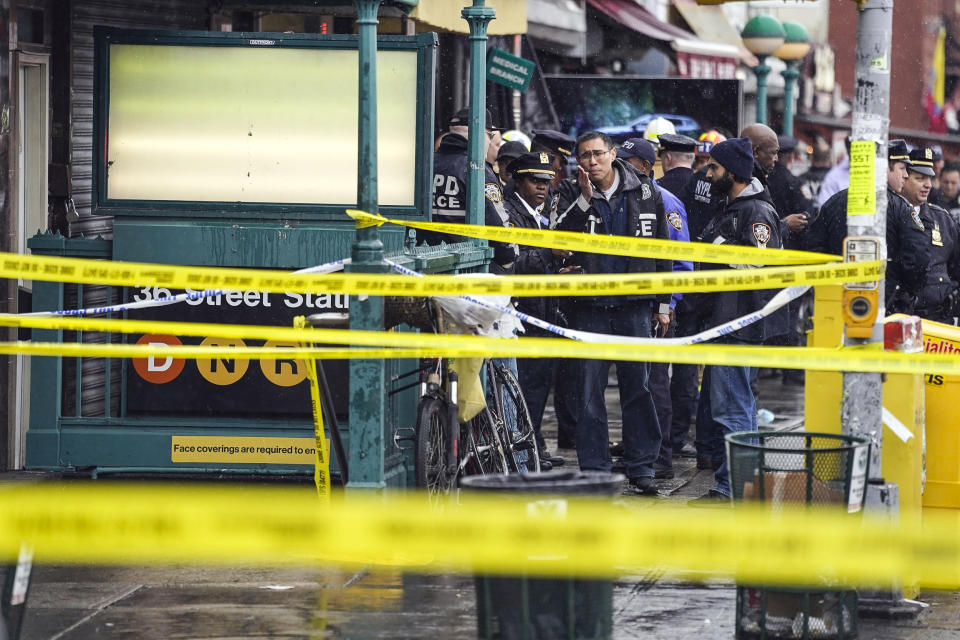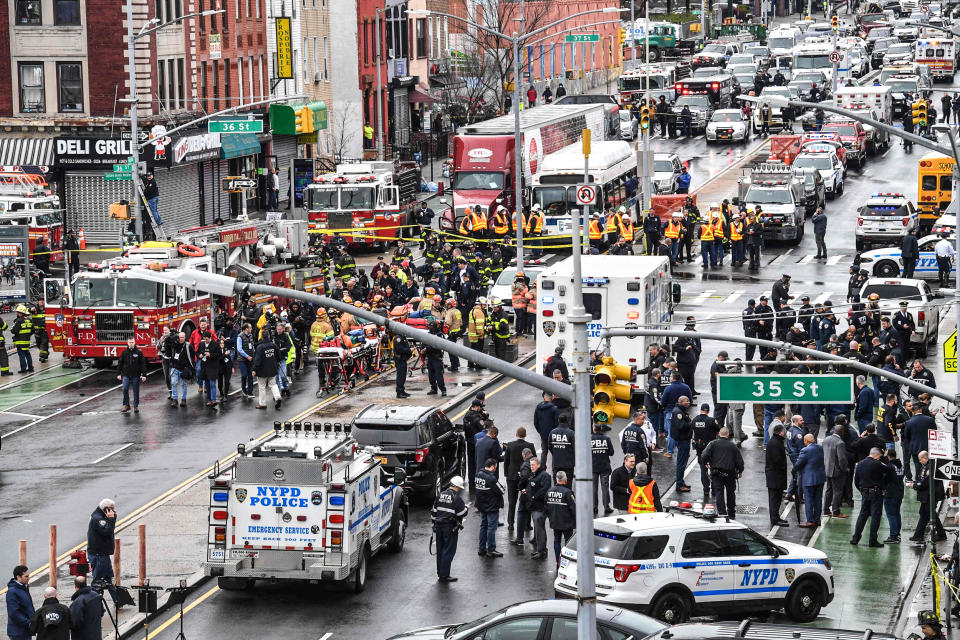Why Brooklyn subway shooting and growing transit crimes threaten NYC's 'return to normal'
- Oops!Something went wrong.Please try again later.
- Oops!Something went wrong.Please try again later.
A shooting in the New York City subway during the rush hour commute Tuesday morning comes amid a rise in violent crime that threatens the "return to normal" messaging being promoted by officials.
A man in a gas mask opened fire on an N train just before it entered the 36th Street station in south Brooklyn, shooting at least 10 people. A wave of high-profile subway attacks has challenged the reopening push of city, state and federal leaders as pandemic restrictions begin to lift.
The "disrupting" of people's lives has to stop, New York Gov. Kathy Hochul said at a news conference after the shooting.
"I'm committing the full resources of our state to fight this surge of crime, this insanity that is seizing our city, because we want to get back to normal," Hochul said. "It has been a long, hard two years. That's what we crave — that sense of stability and normalcy."
Mayor Eric Adams told MSNBC he would continue riding the subway to set an example and promised to double the number of police on the trains to ease apprehension. He said it was vital to recovery.
"This is what I do, I ride the subway," Adams said. "I'm in the subway system 3 or 4 in the morning. Because if I'm telling New Yorkers they can ride the subway, then I need to lead from the front."
Fear and 'tension in the air' over subway commutes
Kondrad Aderer was in the station lobby when a bleeding man came up the stairs from the platform to alert him that people were hurt. He tweeted later, "It's just hitting me how I was on that subway line with my kids" at 8:10 a.m.
In an interview with MSNBC, Aderer said he rushed out of the station just as first responders were arriving.
"It's shocking. You think of this neighborhood being out of the way," Aderer said. "And I didn't know anything about this other than learning bits and pieces as I've been talking to reporters, basically. So to find out this was some kind of mass shooting event ... just feels like a real shock."
Alani Frace, 23, commutes into midtown Manhattan four days a week from Bushwick in Brooklyn. Frace, a student who also works part time, said she doesn't have the option to work from home and that she intends to remain cautious.
"There's definitely some tension in the air," Frace said. "I think it's more so anger at the trains and fear. ... So many people depend" on the trains. "It's a little hard to have a new commute."
Adams pushes safety plans as crime undermines 'return to normal' message
Both public officials and corporations have tried to push workers back into offices. President Joe Biden himself called for a return to offices in his State of the Union address last month.
"It's time for America to get back to work and fill our great downtowns again with people," Biden said. "People working from home can feel safe and begin to return to their offices."

Adams has similarly urged a return-to-normal approach, lifting vaccination and mask mandates throughout the city after two years of pandemic living changed behaviors. At a news conference in February, Adams urged CEOs to end remote work policies and bring people into the city to help stimulate the economy.
"New Yorkers did their job: vaccinated, boosters, taking testing," Adams said at the time. "Now I need them to do one more job — go back to their job."
But a spate of high-profile subway crimes in New York City has complicated the effort to get people back on crowded public transportation and into the workplace.
The death of Michelle Go, an Asian American woman who was killed when she was shoved onto subway tracks in January, shocked many city residents. Then, at least six people were stabbed in a series of attacks in the subway system over a single weekend in February.
Just days later came headlines of a hammer attack, in which a man viciously beat a woman at a Queens subway station.
The New York City transit system is a lifeline that allows residents and visitors alike to travel across the five boroughs every day. The Metropolitan Transit Authority recorded an average of 5.5 million daily riders in 2019, before the pandemic forced millions to stay at home.
Last week, the MTA recorded that ridership ranged from 56 percent to 68 percent of pre-pandemic levels. Tuesday was the busiest day that week, with 3,366,513 riders estimated to have taken the train.
Transit crimes in January increased by 75.2 percent compared to January 2021, according to city data. Reports of knives on city transit have increased by 139 percent since 2019, police said last month.

In his first 100 days in office, Adams released a series of policing initiatives to reduce both violent crimes and what police call "quality of life" crimes.
Adams released a subway safety plan, which focused on the homeless population, and launched the police department's "Neighborhood Safety Teams" to focus on gun violence.
Initiatives the city implemented after a surge of crime in the 1990s were deeply criticized, including a "stop and frisk" policy that a federal judge deemed unconstitutional in 2013 and a plainclothes anti-crime unit that was disbanded in 2020.
Former Police Commissioner William Bratton said it was a tough situation for Adams, Hochul and the newly appointed police commissioner, Keechant Sewell, to "reduce fear, reduce crime and disorder."
"In a few months the mess is theirs. It's not going to be the previous administration's," Bratton said on MSNBC. "And so they've got their work cut out for them."
In response to critics who worried that a crackdown on crime would revert to a policing system that targets people of color, Adams — himself a former New York police officer — insisted last month that he would balance police reform with safety.
"The city is not also going backwards in crime," Adams said. "That is the key here is the balance of justice and safety. I say that over and over again, but only people hear the safety part about it, but it's justice, also."

